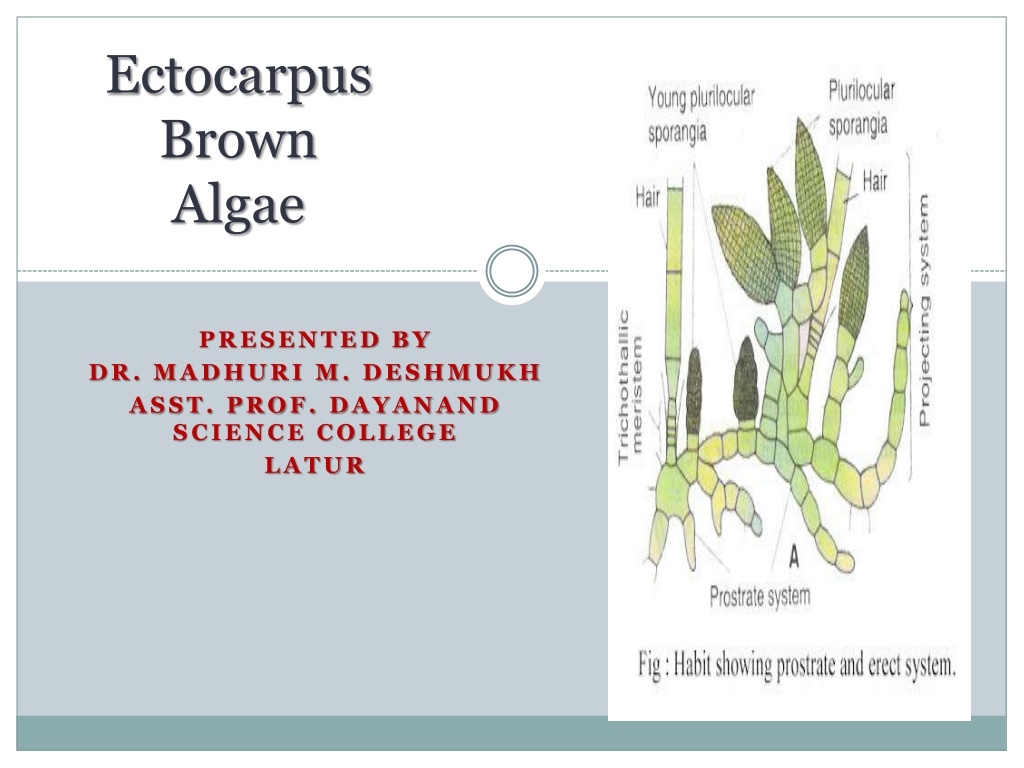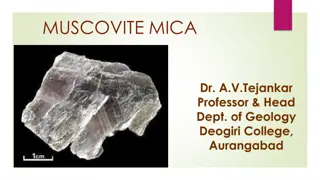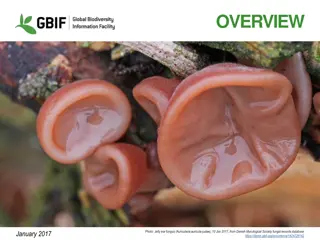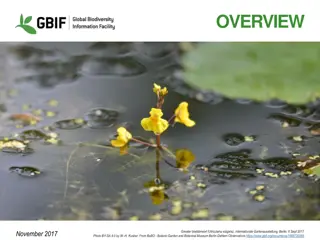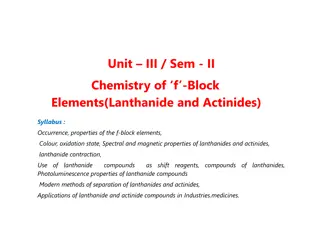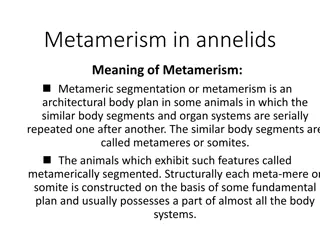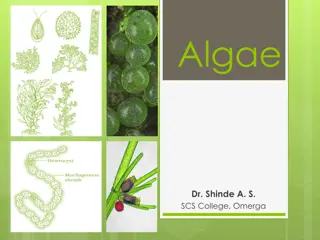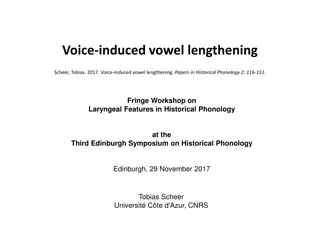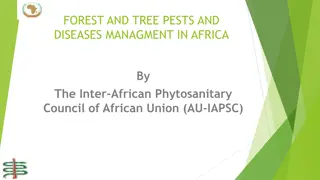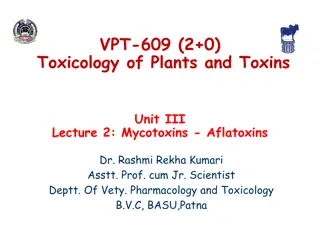Exploring Ectocarpus: Characteristics and Occurrence
Ectocarpus, a brown algae genus, is diverse with species found worldwide, including 16 in India. It thrives in marine habitats as free-floating, epiphytic, or lithophytic forms. The filamentous plant body is heterotrichous, divided into prostrate and erect systems. Two genetic types, haploid and diploid, exhibit morphological similarities. Cell structure shows rectangular/cylindrical cells with a characteristic gelatinous substance in the wall, containing photosynthetic pigments like chlorophyll and fucoxanthin. Ectocarpus serves vital ecological roles in coastal ecosystems.
Download Presentation

Please find below an Image/Link to download the presentation.
The content on the website is provided AS IS for your information and personal use only. It may not be sold, licensed, or shared on other websites without obtaining consent from the author. Download presentation by click this link. If you encounter any issues during the download, it is possible that the publisher has removed the file from their server.
E N D
Presentation Transcript
Ectocarpus Brown Algae PRESENTED BY DR. MADHURI M. DESHMUKH ASST. PROF. DAYANAND SCIENCE COLLEGE LATUR
Occurrence of Ectocarpus: Different species of the genus Ectocarpus (Cr. ekos external and kapos fruit) is found throughout the world, out of which 16 species are found in India. They grow in marine habitat, either free-floating, epiphytes (on other sea plants) or lithophytes (on rocks). They are commonly available in both tropical and temperate seas. In India they are commonly found in the western coast. Species like E. spongiosus and E. conigerare are free-floating, E. breviarticulatus and E. coniferus grow on larger algae like Laminaria and Fucus as epiphytes. E. dermonematis is endophytic and E. fasciculatus is an epizoic species, grows on the fins of fishes
Plant Body of Ectocarpus:- The plant body is filamentous and heterotrichous, which is differentiated into prostrate and erect systems. The prostrate system is profusely branched and attached with the substratum. Some species like E. filiferetc, develop multicellular hairs from the prostrate system. The erect system develops from the prostrate system which remains free-floating. It is much branched and well-developed. Both the main axis and branches are uniseriate (monosi- phohous), but the lower part may become multiseriate
The prostrate system serves the function of anchorage with the substratum or on other plants and the erect system is photosynthetic and bears reproductive organs. The apical part of each filament generally terminates into hairs. Two types of plant bodies are differentiated genetically, one is haploid and other one is diploid. Both haploid and diploid plants are morphogically identical
Cell Structure of Ectocarpus: The cells are rectangular or cylindrical Cell wall is differentiated into outer pectic and inner cellulosic layers. The characteristic gelatinous substance present in the cell wall is composed of algin and fucoiden. Inner to the wall, cell membrane is present which encircles the protoplast. The protoplast contains one central nucleus and many chromatophores. The number and shape of chromatophore varies with species. They may be ribbon-shaped, band-shaped, discoid etc. and are associated with pyrenoids.
The photosynthetic pigments are chlorophyll a, chlorophyll c, -carotene and fucoxanthin. The fucoxanthin masks the chlorophyll and gives the characteristic brown colouration. The cytoplasm contains many vacuoles, which are called physodes. The physodes contain polyphenols, probably function as lysosomes. Morphologically, haploid and diploid vegetative filaments are almost alike, but the cells of haploid filaments are comparatively shorter in length than the diploid filaments.
GROWTH The nature of growth varies with the region of plant body and also with species. The erect system shows intercalary, diffuse or trichothallic growth, whereas it is apical in prostrate system. Features of Ectocarpus: 1. It is a marine brown alga, distributed throughout the temperate and tropical seas of the world. 2. Plant body is filamentous, much branched and heterotrichous, having basal rhizoids and well- developed branched erect system. 3. Both sporophytic and gametophytic plants are alike (isomorphic).
4. The sporophytic plant bears both plurilocular and unilocular sporangia. The plurilocular sporangium produces zoospores (2n) through mitosis. They germinate to produce new diploid sporophytic plant. On the other hand, unilocular sporangium produces zoomeiospore through meiosis, followed by several mitotic divisions. Zoomeiospores on germination develop gametophytic plants. 5. The gametophytic plants bear plurilocular gametangia (look similar to plurilocular sporangia) produce gametes.
6. anisogamous but oogamous absent type. Physiological anisogamy is very common. 7. Direct germination of zygote results in the formation of a diploid sporophytic plant. Sexual reproduction may be isogamous, Ectocarpus reproduces both asexually and sexually: Asexual Reproduction: It takes place by zoospores. The zoospores are biflagellate having one whiplash and other tinsel-type of flagellum. The diploid plant (2n) develops two types of sporangia. These are unilocular sporangia and pleurilocular or neutral sporangia (Fig. 3.11 OB, C). The unilocular sporangia develop haploid zoospores i.e., zoomeiospores, but the plurilocular sporangia develop diploid zoospores
The unilocular sporangia develop from the apical cell of short lateral branches The apical cell enlarges and functions as sporangial initial. The diploid nucleus of the initial first undergoes meiosis followed by several mitotic divisions, thus 32-64 hapioid nuclei are formed. These nuclei accumulate some cytoplasm and develop individual units. Each unit metamorphoses into a pyriform, uninucleate, biflagellate zoospore also called zoomeiospore. The flagella are unequal and laterally inserted. Out of two flagella, posterior one is short and whiplash type (i.e., acronematic) and the anterior one is larger and tinsel type (i.e., pantonematic).
On contact with suitable substratum, the zoospore withdraws its flagella and forms a new cell wall around it . Within short time a germ tube is formed, which divides many times and form prostrate filament . Some cells of the prostrate filament become active and form erect filaments. Thus the plants developed on germination of haploid zoospores (i.e., zoomeiospores) are gametophytic. Plurilocular Sporangium These are elongated, multicellular body developed on diploid (2n) i.e., sporophytic plant body. They develop initially like the unilocular sporangia, at the tip of short lateral branches. The apical cell enlarges and functions as sporangial initial. This sporangial initial becomes enlarged and undergoes repeated mitotic division, thus 6-12 cells are formed. The cells are arranged in vertical row
The cells then undergo several vertical divisions thus a multi- chambered structure is formed i.e., the plurilocular sporangium. There is no reduction division during the formation of zoospore in plurilocular sporangium. So, each small cubical cells of plurilocular sporangium contains single diploid nucleus. Each unit then metamorphoses into a single, uninucleate (2n) and biflagellate zoospore. The zoospores formed from plurilocular sporangia are alike with the zoospores i.e., zoomeiospores developed in unilocular sporangia but are diploid
The zoospores of plurilocular sporangia liberate through apical or lateral aperture and on germination they produce the sporophytic (2n) plant. They develop initially like the unilocular sporangia, at the tip of short lateral branches. The apical cell enlarges and functions as sporangial initial. This sporangial initial becomes enlarged and undergoes repeated mitotic division, thus 6-12 cells are formed. The cells are arranged in vertical row
The cells then undergo several vertical divisions thus a multi- chambered structure is formed i.e., the plurilocular sporangium . There is no reduction division during the formation of zoospore in plurilocular sporangium. So, each small cubical cells of plurilocular sporangium contains single diploid nucleus. Each unit then metamorphoses into a single, uninucleate (2n) and biflagellate zoospore. The zoospores formed from plurilocular sporangia are alike with the zoospores i.e., zoomeiospores developed in unilocular sporangia but are diploid. The zoospores of plurilocular sporangia liberate through apical or lateral aperture and on germination they produce the sporophytic (2n) plant.
The sexual reproduction is both isogamous and anisogamous type. Oogamy is absent. Anisogamy is very common. Anisogamy may be of two types : morphological anisogamy (E. secundus) and physiological anisogamy (E. siliculosus). The gametes are produced inside the plurilocular gametangia, developed on haploid plants. Plurilocular Gametangia: They are large, elongated, sessile or short stalked, multicellular structures . Morphologically, both plurilocular gametangia and plurilocular sporangia are alike.
The plurilocular gametangia produce haploid gametes; on the other hand plurilocular sporangia produce diploid zoospores. Though both are morphologically more or less alike, the gametes are slightly smaller in size than the zoospores. The development of plurilocular gametangia is alike with the development of plurilocular sporangia. The gametes are liberated from the gametangia following the same procedure as that of zoospore liberation from the plurilocular sporangia
Fertilisation: Majority of the species show physiological anisogamy (Fritsch, 1945), but morphological anisogamy is observed in E. secundus. In physiological anisogamy both the uniting gametes are morphologically similar but in morphological anisogamy female gamete is larger than the male gametes. During fertilisation, many male gametes encircle the female gamete and get entangled by the anterior large flagellum. This stage is called clump formation . Out of many, only one male gamete fuses with the female gamete and the remaining gametes go astray and gradually get destroyed. The uniting gametes then form zygote, through plasmogamy and karyo- gamy.
Germination of Zygote: The zygote undergoes germination without any reduction division and rest. On germination it develops into a sporophytic (2n) plant. The sporophytic plant again develops unilocular and plurilocular sporangia. Common Indian species: Ectocarpus arabicus, E. filife, E. enhali, E. coniger, E. zeylanicus, E. rhodochortonoides etc. Life Cycle of Ectocarpus
